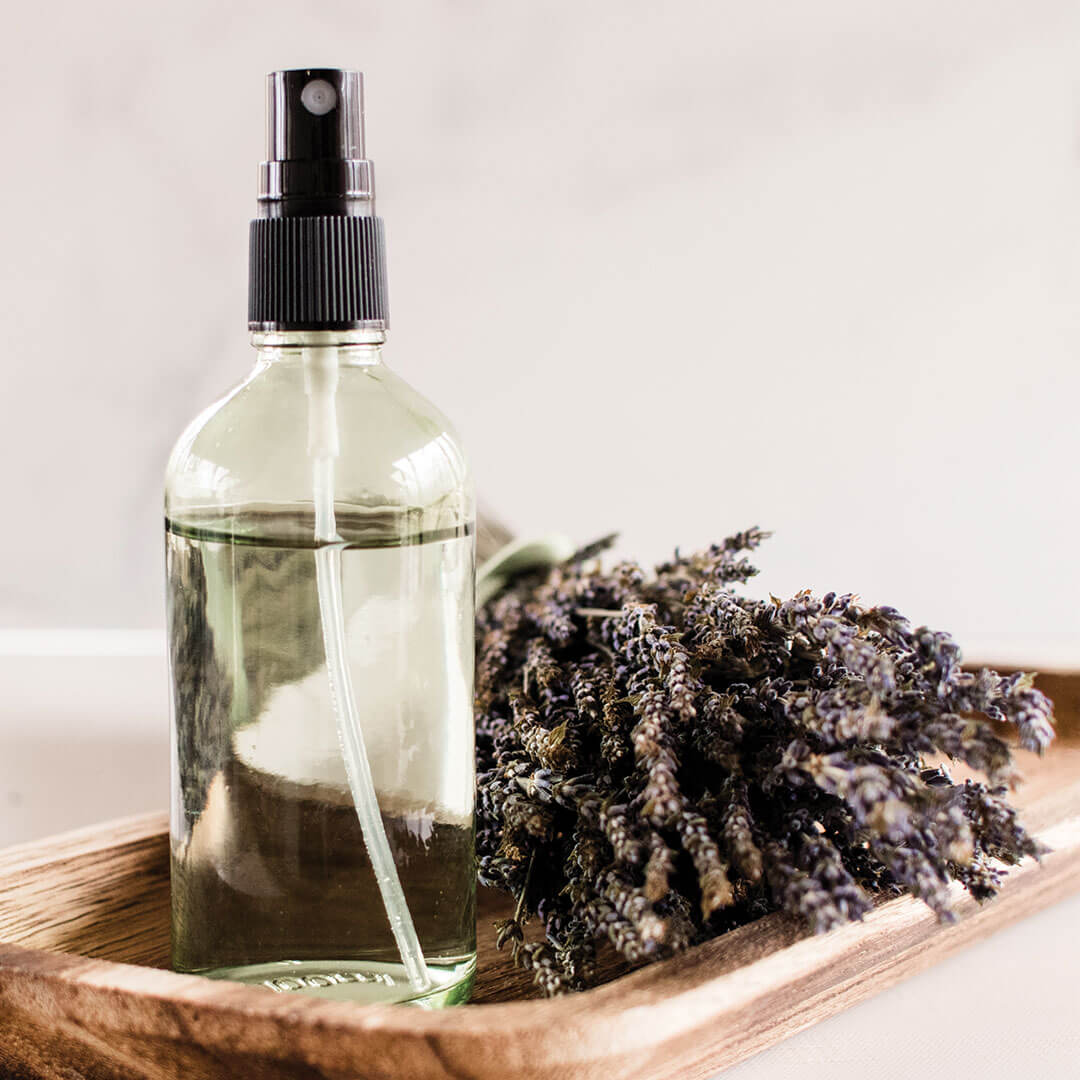Lavender Oil: Everything You Need to Know
1 Comment
Photo Credit: Laura Ascher
Did you know the ancient Egyptians, Romans, and Greeks all used lavender oil as perfume and even for mummification? Lavender has nowadays become the most popular essential oil in the world, yet the discovery of its benefits dates back more than 2,500 years ago.
From the olden days, lavender has long captivated our senses and enchanted us with its delicate fragrance. But its benefits extend far beyond its aromatic allure. Join us as we delve into lavender oil’s many benefits, therapeutic properties, and versatile uses. Whether you’re a seasoned lavender enthusiast or new to its enchantment, find answers to your questions here.
Table of Contents
• What is Lavender Oil Exactly?
What is Lavender Oil Exactly?
Lavender oil, or if you prefer its harder-to-read scientific name, Lavandula angustifolia, is an essential oil extracted from the lavender flower. The name lavender derives from the Latin verb “lavare,” meaning “to wash.” And while cultivated worldwide, lavender originates in the Mediterranean, Russia, and the Arabian Peninsula.
Within the category of Lavandula, there are at least 47 lavender species. Each lavender species within the Lavandula genus possesses unique characteristics, like variations in fragrance. From Lavandula angustifolia (English lavender) to Lavandula stoechas (Spanish lavender), this group showcases how diverse lavender can be.
So, how can you get lavender essential oil from lavender? Extracting it involves a steam distillation process. After you steam the fragrant flowers, you can separate and collect the oil from the captured steam. More straightforwardly, you can get lavender oil at drugstores and health food stores alongside other essential oils.
Lavender Oil Properties
Antimicrobial Property
Lavender essential oils have a long history of medicinal use ever since medieval times. De la Croix was the first scientist to study lavender for its ability to kill bacteria. More research has then demonstrated lavender can kill microorganisms like bacteria or mold, thanks to its unique chemical composition.
Anxiolytic Property
Lavender’s most promising property is probably its delightful scent, which is intriguingly well-researched in dentistry. Dental practitioners have recently been exploring more affordable ways of providing behavior therapy. One of the emerging approaches gaining acceptance is aromatherapy. This practice involves using the pleasant aroma of lavender to help patients feel more at ease during dental procedures.
Anti-inflammatory Property
Lavender can also reduce inflammation. It can be in use to treat skin conditions like dermatitis and eczema. In a study with animals, lavender oil was even as effective as an anti-inflammatory medicine. Scientists believe the essential oil works by interacting with a specific receptor in our body or affecting cell communication.
Preservative Property
Scientific studies have confirmed that lavender oil can be a preservative for strawberries. Moreover, the essential oil has demonstrated potential as a natural preservative in local anesthetic solutions. Because of that, it offers both preservation properties and potential alternatives to synthetic preservatives.
Toxicity
Using commercial essential oils may come with potential risks of toxicity. Several factors contribute to this, including product handling, ingredients, excessive or improper usage, and sensitization or allergic reactions. Therefore, you should be mindful of possible adverse effects. Some studies have reported additional side effects of lavender essential oil, such as contact dermatitis and allergic reactions causing facial dermatitis.
7 Benefits of Lavender Oil
For Managing Stress
The calming effects of lavender essential oil extend beyond relaxation. In recent times, it has gained recognition from research for its remarkable potential in safeguarding against neurological damage. This finding comes as no surprise. Why? Lavender has a long-standing reputation in traditional medicine for addressing nerve-related issues such as migraines and stress.
In a study comparing lavender essential oil to a prescription drug for anxiety, researchers discovered that the essential oil held its ground. Over six weeks, one group took anxiety medication, and the other received an oral dosage of the essential oil. Surprisingly, both groups experienced a nearly identical reduction in anxiety levels – 45% and 46%, respectively.
Another 2019 study shows that lavender oil inhalation reduces peri-operative anxiety and can even be a potential sedative. On top of that, lavender has also been effective in addressing PTSD symptoms. In a phase-two trial, depression decreased by 33 percent due to an 80-milligram daily dose of the essential oil.
For Face Wrinkles
Free radicals, like pollutants and toxins, are the culprit behind the formation of fine lines and wrinkles on the face. When the body encounters free radical damage, it activates its natural defense mechanism by producing antioxidant enzymes. However, the body can become deficient in antioxidants when overburdened.
Fortunately, you have lavender essential oil as a natural antioxidant to help shield the skin from these harmful free radicals.
For Sleep and Insomnia
No matter how you look at it, sleep forms the cornerstone of a healthy lifestyle. If you struggle with restless nights, lavender oil might be the key to your sleep woes.
A study found that inhaling the calming scent of lavender before bedtime increased the duration of deep sleep. Furthermore, for individuals dealing with insomnia, a separate study revealed that inhaling lavender oil improved sleep quality in the participating women. Inhaling the essential oil for 20 minutes twice a week had a soothing effect on their nervous system.
For Headaches
If you find yourself among the countless people grappling with tension or migraine headaches, lavender oil can lend a helping hand. Considered the top essential oil for headaches, lavender oil is a calming agent and helps your brain relax.
In a study published in European Neurology, 92 out of 129 participants experienced reduced headaches after inhaling the essential oil for 15 minutes.
For Burns and Cuts
Lavender has long been known for its wound-healing properties – minor wounds, of course. Over 100 studies have pointed out this benefit of lavender. Thanks to its antimicrobial compounds, lavender can promote faster healing of burns, cuts, wounds, and scrapes.
In a 2016 study, lavender enhanced wound healing through collagen synthesis and granulation tissue formation. So there was a significant decrease in wound size compared to the control group. The catch: this research was on rodents, so remember that lavender essential oil can’t just replace Neosporin.
Related: How to Naturally Treat Body Aches with Essential Oils
For Fungal Infections
Athlete’s foot, ringworm, and yeast infections – no one likes these. Among essential oils like tea tree, clove, and cinnamon, lavender is most effective in fighting fungal infections.
A laboratory study demonstrated lavender’s effectiveness in inhibiting candida, the fungus responsible for yeast infections. Meanwhile, another showed that lavender could also fend off Staph aureus, a common cause of skin fungi and respiratory pneumonia.
For Angry Skin and Bug Bites
By now, you know that lavender has a dual effect on the body, providing mental and physical relief. With skin conditions like psoriasis and eczema, the anti-inflammatory properties of lavender have shown positive results.
A review of essential oils in dermatology highlighted lavender oil’s ability to soothe irritated skin when applied topically. Likewise, the oil’s stress-relieving properties can be beneficial for managing psoriasis, as stress often triggers flare-ups. When combined with baking soda, lavender essential oil can also become a natural remedy for bug bites.
8 Ways to Use Lavender Oil
Aromatherapy
Create a soothing atmosphere by adding a few drops of lavender oil to an oil burner or diffuser. The gentle scent will help create a calming and relaxing environment.
Massage
For the safe use of lavender essential oil on the skin, don’t forget to use a carrier oil. Dilute the essential oil using a carrier oil and get excited for a relaxing massage. Popular carrier oils include almond, jojoba oil, and coconut. To apply the mixture, gently massage it into the skin using your fingers or cotton pads.
Incorporating lavender oil into your massage can help ease muscle tension and foster a sense of well-being.
Bath
Elevate your bathing experience by using lavender essential oil. Begin by running warm water in your bathtub to a comfortable temperature. Once the tub is ready, add several drops of lavender oil into the water and swirl it to disperse the oil.
Pillow Spray
Create a pillow spray by mixing a few drops of lavender oil with water in a spray bottle. Before bedtime, spritz it on your pillow for peaceful sleep.
Skin Care
Make lavender oil part of your skincare routine by adding a few drops to your favorite unscented lotion or carrier oil. Apply it to your skin to enjoy its moisturizing and soothing properties.
Related: 3 Lavender Skin-Care Recipes We Love
Inhalation
Place a few lavender drops on a cotton ball or a tissue and inhale deeply. Do this, and you’ll have a quick and effective way to uplift your mood.
All-Purpose Cleaners
Lavender can be an ingredient for your all-purpose cleaner. Spray the lavender-infused cleaner onto surfaces like glass, tiles, or countertops, then wipe them clean with a sponge or cloth. The essential oil will provide a pleasant scent while offering potential antimicrobial properties.
Here’s how you can make it:
Ingredients:
• White vinegar (1/4 cup)
• Water (2 cups)
• Lavender essential oil (10-15 drops)
Instructions:
1. Combine the white vinegar and water in a spray bottle
2. Add the essential oil to the mixture
3. Secure the spray bottle cap and ensure thorough mixing by shaking well
Remember to use it in moderation to avoid residues on surfaces.
DIY Projects
Get creative and use lavender in your DIY projects. Make homemade candles, bath salts, body scrubs, body spray, or air fresheners using lavender as a fragrant ingredient.
Here’s how to make Vanilla Lavender Body Spray by Laura Ascher, from the pages of Willow and Sage Summer 2023:
You Will Need:
• 2 TB. of unscented witch hazel
• 1 TB. of castor oil
• 15 drops of essential oil blend
• Glass spray bottle: 2 oz.
“Day at the Office” Essential Oil Blend Recipe:
• 10 drops of lavender
• 5 drops of vanilla
To Make:
Add all the ingredients to a glass spray bottle, secure the lid, and shake well to combine. To use, shake well and mist on your wrist, neck, or clothing as often as desired. Store it out of direct sunlight to prevent the essential oils from losing their potency. To help the scent last longer, apply it to semi-damp skin.
“The floral scent of lavender combined with the delicious aroma of vanilla bean is the ideal combination to add to the perfect body spray for any occasion.” – Laura Ascher.
Questions You May Ask
What Are the Possible Side Effects of Lavender Oil?
Lavender essential oil may cause allergic reactions or skin irritation in some people. If you experience symptoms like headaches, vomiting, or nausea after using the essential oil, discontinue immediately.
Additionally, consuming lavender essential oil can be toxic. And it should only be under the guidance of a healthcare professional. It’s crucial to exercise caution and avoid ingesting the essential oil without proper medical supervision.
Is Lavender Oil Safe for Cats?
A 2018 Facebook post went viral as a woman accidentally harmed her cat by using essential oils to treat her cold. Indeed, some people don’t realize that cats and essential oils don’t mix.
Reliable research on the benefits of essential oils for pets is limited compared to those on humans. The few existing studies are often by companies producing herbal-infused pet products.
Cats have a distinct metabolism and sensitivity to specific compounds in essential oils, making them more prone to experiencing adverse reactions. That’s why certain essential oils are toxic for cats. And unless used in appropriate dilutions and under veterinary guidance, lavender can be one of them.
Because of that, you shouldn’t let your cat be near lavender essential oils. That includes active diffusers.
Can I Use Clean Wood Surfaces With Lavender Oil?
You shouldn’t use lavender essential oil on porous surfaces like wood. The essential oil can penetrate the material and may cause staining. Similarly, using lavender oil on fabrics may result in discoloration or staining because of its strong scent. You should likewise avoid using pure lavender essential oils on delicate surfaces such as marble.
Can Lavender Oil Cure Baldness?
Several studies have indicated the potential of lavender oil to promote hair growth. For instance, the topical application of the diluted essential oil led to significant hair growth in a 2016 study.
You might also enjoy:
• Everything you need to know about Lavender Oil.
• 3 Lavender Skin-Care Recipes We Love
• Create Your Own Soothing Mint Lavender Mineral Bath
Find this information fascinating? Discover more insights, bath and body recipes, and much more await you in our latest issue of Willow and Sage.
















One thought on “Lavender Oil: Everything You Need to Know”